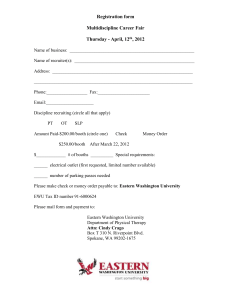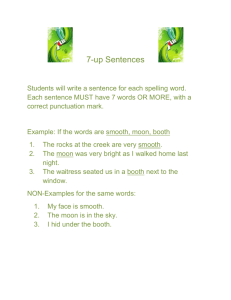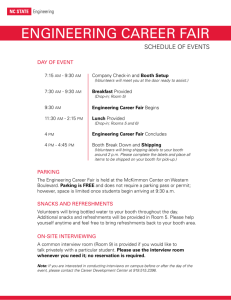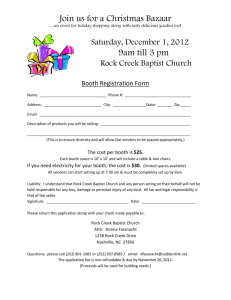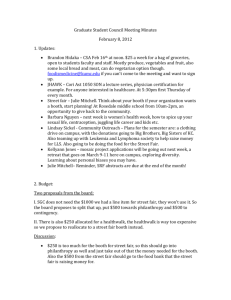SPECIAL EVENTS – FOOD SAFETY QUIZ
advertisement
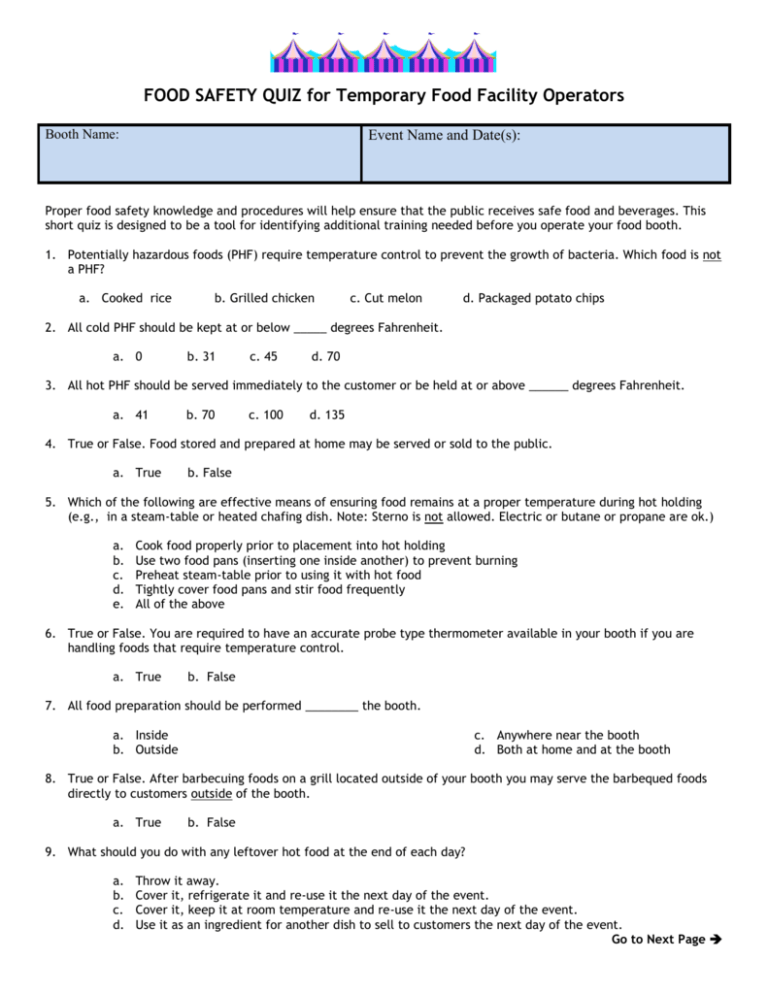
FOOD SAFETY QUIZ for Temporary Food Facility Operators Booth Name: Event Name and Date(s): Proper food safety knowledge and procedures will help ensure that the public receives safe food and beverages. This short quiz is designed to be a tool for identifying additional training needed before you operate your food booth. 1. Potentially hazardous foods (PHF) require temperature control to prevent the growth of bacteria. Which food is not a PHF? a. Cooked rice b. Grilled chicken c. Cut melon d. Packaged potato chips 2. All cold PHF should be kept at or below _____ degrees Fahrenheit. a. 0 b. 31 c. 45 d. 70 3. All hot PHF should be served immediately to the customer or be held at or above ______ degrees Fahrenheit. a. 41 b. 70 c. 100 d. 135 4. True or False. Food stored and prepared at home may be served or sold to the public. a. True b. False 5. Which of the following are effective means of ensuring food remains at a proper temperature during hot holding (e.g., in a steam-table or heated chafing dish. Note: Sterno is not allowed. Electric or butane or propane are ok.) a. b. c. d. e. Cook food properly prior to placement into hot holding Use two food pans (inserting one inside another) to prevent burning Preheat steam-table prior to using it with hot food Tightly cover food pans and stir food frequently All of the above 6. True or False. You are required to have an accurate probe type thermometer available in your booth if you are handling foods that require temperature control. a. True b. False 7. All food preparation should be performed ________ the booth. a. Inside b. Outside c. Anywhere near the booth d. Both at home and at the booth 8. True or False. After barbecuing foods on a grill located outside of your booth you may serve the barbequed foods directly to customers outside of the booth. a. True b. False 9. What should you do with any leftover hot food at the end of each day? a. b. c. d. Throw it away. Cover it, refrigerate it and re-use it the next day of the event. Cover it, keep it at room temperature and re-use it the next day of the event. Use it as an ingredient for another dish to sell to customers the next day of the event. Go to Next Page 10. How should self-serve condiments be available to customers? a. In squeeze bottles b. In containers with a hinged lid c. In individual packets d. Any of the above 11. The following tasks should be assigned to different workers in your food booth: handling money, preparing readyto-eat food, handling raw meat and poultry. Why? 12. True or False. A person in charge shall be present in the booth during all hours of operation. a. True b. False 13. When should a food handler wash his or her hands? a. After touching his or her face b. After touching money c. After using the restroom d. All of the above 14. True or False. Food handlers are required to minimize bare hand contact with ready-to-eat foods by wearing gloves, by using utensils or other implements to handle food. a. True b. False 15. A utensil washing station is not required in your booth if: a. Only packaged food is sold b. Unpackaged food is prepared in your booth c. Utensils are used d. Equipment is used 16. Utensil wash stations should have at least 3 buckets: (1) for soapy water, (2) for rinsing, and (3) for sanitizing. When using chlorine bleach as a sanitizer, how much should be used? a. b. c. d. 1/4 teaspoon per 2 gallons of fresh, potable water 1/2 teaspoon per 2 gallons of fresh, potable water 1 teaspoon per 2 gallons of fresh, potable water 1 tablespoon per each gallon of fresh, potable water 17. What 4 items are important to have at your booth’s handwash station? (1) (2) (3) (4) 18. True or False. Food booths with unpackaged food are required to supply warm water (at least 100˚F) for handwashing purposes. a. True b. False 19. In your booth, at least ____ gallons of water is required for handwashing and at least _____ gallons of water total is required for food preparation and utensil washing. a. 1; 5 b. 5; 5 c. 5; 10 d. 5; 25 20. True or False. Wash water and other liquid waste (ice melt, etc.) may be drained into a leak-proof container and then disposed of onto the ground or into storm drains. a. True b. False Your Name (Print): Phone Number: Your Signature: Today’s Date:
